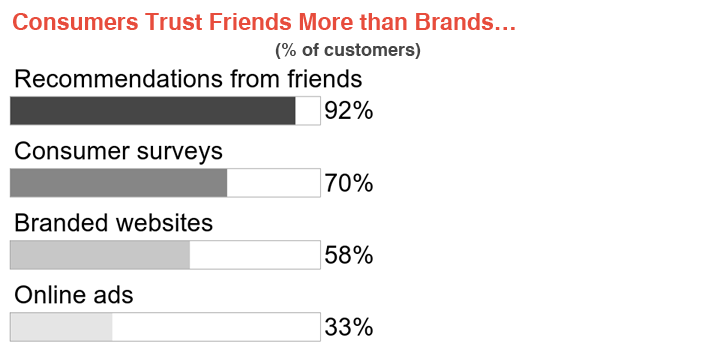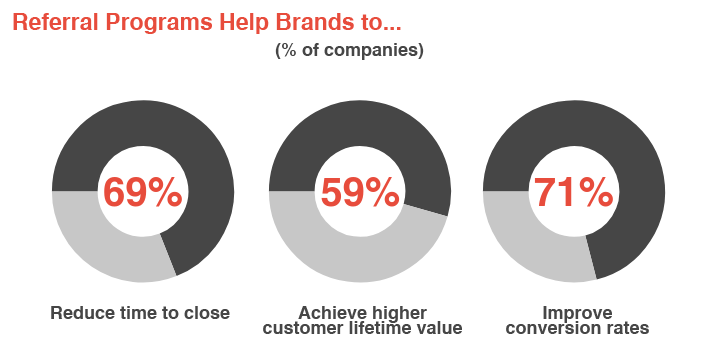
It’s a common knowledge that 84% B2B decision makers start the buying process with a referral. What about B2C segment? How can a referral program help you attract new customers and keep the old ones? Check out these referral program examples and…learn from the best!
Successful B2C referral program examples
- Airbnb. Airbnb, an online hospitality service that began with a concierge MVP ten years ago and will be making $ 3.5 billion annually by 2020, is not new to referral marketing. The company’s revamped referral program (the original one was barely findable on their website – and there was no app for it) encourages travelers to recommend the service to their friends, rewards both parties with a $ 25 bonus and allows users to send invitations across three channels including the Airbnb website and mobile apps (iOS, Android). The program also attracts new hosts who get cash rewards if they have visitors within 150 days from the day they’ve been invited. Although it took Airbnb 3 months and over 30 thousand lines of code to bring the new program to life, the strategy increased bookings by 25% in certain regions;
- PayPal. Another tycoon on our list, the online payments company implemented a referral program to astonishing results (7-10% daily growth, 100+ million members by Q2 2011). PayPal dropped the refer-a-friend and merchant bonuses ($ 20) once they’d achieved the desired results; how come their user base has surpassed 210 million registered accounts this year? With Apple Pay, Google Wallet and Bitcoin on their back, the company could no longer ignore referrals and has launched another program earlier this year, giving users an opportunity to earn up to $ 100 for inviting a friend via the PayPal mobile app;
- Amazon. The world’s third-largest retailer is no stranger to referral marketing. Back in 2015 the company (they obviously felt having a number one shopping app on the App Store was not enough!) rolled out a referral program offering $ 5 to mobile users who refer the app to a friend (and $ 5 to the friend in question). The rewards came in the form of Amazon coupons and could only be redeemed after the person you’d referred the program to made their first purchase via the application. Unlike previous Amazon referral efforts, the 2015 program enabled customers to invite friends directly from their phone contacts (as opposed to sharing promo content on social media). The results? This year, Amazon has become the app that 35% of people aged between 18 and 34 (aka Millennials and Centennials) can’t live without;
- Uber. The company’s success (FYI, Uber now operates in over 80 countries around the globe) can be largely attributed to its clever referral programs (one is for passengers and the other is for drivers). The program for riders offers $ 20 to both the person who recommends the app to a friend and the person who sets up an Uber account following the invitation. The program promotes a solid product, benefits everyone and is easy to share – and that’s what made it an instant hit. When it comes to drivers, Ubers rewards employees who refer the job to drivers with ridesharing experience with $ 500 in cash (and $ 100 for bringing new employees with no relevant experience);
- Evernote. It does seem like Evernote’s been organizing our lives forever, but the smart program that now lists over 200 million users was only launched 10 years ago. Besides excellent app performance (and providing real value to users!), Evernote’s growth is driven by its simple, cheap and extremely effective referral program. Evernote users who recommend the service to their friends and social media followers get 5 or 10 bonus points for every person who clicks on the link they’ve shared (which can be sent directly via email or posted on Facebook and Twitter). The points can then be swapped for an Evernote Premium account, while the registered users you’ve referred the system to get a one-month access to Premium just for getting started.
How to succeed in referral marketing?
What do these successful referral programs have in common?
- They target brand advocates – that is, loyal users who clearly enjoy a product/service and are likely to recommend it to a friend;
- The brands have made their programs easy to share: all you have to do is copy-paste the link or choose the guys you’d like to invite from your contacts list. Also, pay closer attention to Uber’s UX strategy: it only takes users 5 minutes to download the app and get their first ride (the fare will most likely be covered by the $ 20 bonus);
- All of the programs are focused on mobile users (after all, 55.79% of customers now surf the Web from mobile devices, while apps account for 92% of users’ mobile time);
- Last but not least, top referral programs award both the users who promote a product/service and new customers.
So, you want to make referrals part of your marketing strategy?
Pavel Vaskou, Head of iOS Development Unit at R-Style Lab, has recently worked on Addzer – a B2C customer referral program for café and restaurant chains (you can read the case study here). Based on his experience, Pavel identified the key elements of a successful referral system:
- Web presence (desktop is still a thing – and you need a web-based admin console to manage app content and customer data, too);
- Mobile presence (here the term refers to both mobile apps and a stylish responsive website);
- Email sharing (60% of marketers claim email still outperforms social media – and users are more likely to open a letter from a friend than another spam email anyway);
- Social media integration. Whether you want to design a website- or mobile-based referral program, the integration with popular social networks including Facebook and Twitter is essential (the feature enables easy content sharing and user authentication);
- Campaign and promo code management tools. The word-of-mouth effect is only achieved by brands that focus on continues engagement. Novelty wears off – and that’s why the best referral programs evolve over time. According to Pavel, a successful referral program should also incorporate the elements of a loyalty program (in fact, you can build a mobile app supporting both functions and thus save a few thousand dollars). Be flexible, offer new perks to new and existing customers, turn to gamification – and success will follow!
By the way, the r-stylelab.com team also recommends that you take an iterative approach to B2C referral program development, conduct A/B testing to see what features work best and polish your product. When done right (that is, created with particular goals in mind), a referral program can be a real game changer.

